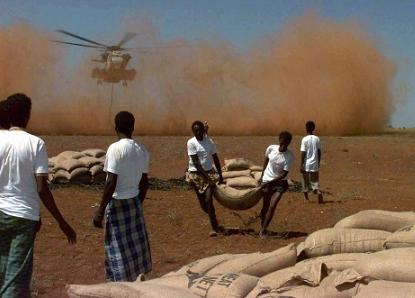Source: The New Internationalist
 Famine has returned to Somalia, and so has the US military. This is no natural disaster. Just as the US sent its first drones to Somalia, targeting leaders of the militant Islamist group al-Shabaab, tens of thousands of Somalis were crossing into Kenya, fleeing a catastrophic drought and conflict.
Famine has returned to Somalia, and so has the US military. This is no natural disaster. Just as the US sent its first drones to Somalia, targeting leaders of the militant Islamist group al-Shabaab, tens of thousands of Somalis were crossing into Kenya, fleeing a catastrophic drought and conflict.
While US drones were able to find their targets in Somalia with pinpoint accuracy, humanitarian agencies have had less luck. They have experienced a catastrophic decline in access that has destroyed their ability to assist and protect civilians. The families crossing into Kenya are escaping from a severe drought but they are also fleeing a war.
This is a conflict between the internationally sponsored Transitional Federal Government (TFG) and a militant Islamic movement al-Shabaab, which is listed as a terrorist organization. The political use of aid by the warring parties has eroded the humanitarian space that agencies need to operate safely and securely.
Back in the 1990s, the international community mounted an unprecedented armed humanitarian intervention in the face of a famine that followed the collapse of the Somali state. Today it is different. For the past two years only a handful of foreign aid agencies have been able to work in the country because Somalia has become one of the most dangerous places in the world for aid workers.
International strategic interest in Somalia waned with the humbling of US forces when US Blackhawk helicopters were shot down in Mogadishu. This was compounded by the failure of the UN mission to end the conflict and restore a functioning state.
The 9/11 attacks on America revived international interest. Somalia was now viewed through a new prism, as a failed state and a potential haven for al-Qaeda. In addition, the presence of Islamic jihadist groups catapulted Somalia into the global war on terror. Suddenly the restoration of a central government was a key strategy.
But the authority of the internationally backed Transitional Federal Government was challenged in 2006 when a confederation of Islamic courts took control of Mogadishu and much of south central Somalia. Within six months, Ethiopia had intervened militarily, backed by US airstrikes. The courts were ousted from Mogadishu and the transitional government installed with an African Union peacekeeping force (AMISOM) deployed to protect it.
Since then there has been an inexorable rise in the humanitarian crisis in Somalia. The policy to restore internal order to Somalia has had the opposite effect. The Ethiopian occupation fuelled support for the increasingly militant al-Shabaab that emerged from the ruins of the Islamic courts. The fighting in Mogadishu has killed over 18,000 civilians, displaced up to 1 million people, and caused tens of thousands to flee the country.
The ability of international agencies to respond to the humanitarian catastrophe has declined in inverse proportion to needs. Their neutrality was compromised by international support for the TFG that included the provision of weapons and training of its security forces, the assassination of al-Shabaab leadership and overt attempts to deploy aid in support of the TFG.
Violence against aid workers increased. Al-Shabaab accused aid agencies of being western spies. Some were expelled while others found their work restricted through taxation and other demands. Other aid agencies have fallen foul of US domestic antiterrorism legislation that places strict conditionalities on assistance.
The World Food Programme suspended its operations in Somalia in December 2009 when the UN estimated 3.2 million people were in need of food aid. Their largest donor, the US government, had suspended funding out of concern that the aid was benefiting al-Shabaab; they faced unacceptable attacks and demands on their staff and expulsion by al-Shabaab. Good harvests in 2010 off-set the immediate impact of the loss of food aid. But by early 2011, following another failure of rains, the UN monitoring systems were reporting alarming levels of malnutrition and increasing numbers of families from Somalia seeking refuge in Kenya.
The famine declared in Somalia by the UN on 20 July 2011 is not simply a consequence of drought, but the result of war, international policy and climatic conditions.
The international community became a belligerent in the war and gave primacy to security interests over human need and protection. By using aid to further their political and security agendas, foreign donors lost sight of the principles that guide humanitarian assistance.They have yet to face up to the harm they have been doing in Somalia.
Mark Bradbury is Director of the Rift Valley Institute Horn of Africa Course.
This draws on the Briefing Paper ‘Statebuilding, Counterterrorism and Licensing Humanitarianism in Somalia’ by Mark Bradbury, published by the Feinstein International Centre, September 2010.
Photo by Expert Infantry under a CC licence.
